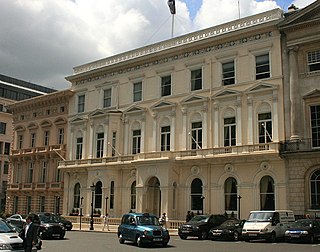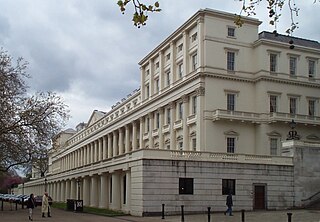History
Attendees at the inaugural meeting on 29 July 1840 were Quintin Dick MP, Viscount Castlereagh MP, W. S. Blackstone MP, the Hon. Captain Duncombe MP, Thomas Hawkes MP, W. A. Mackinnon MP, John Neeld MP, P. D. Pauncefort Duncombe, Charles Hopkinson, and Thomas Walford. At first, the club met in the Lansdowne Hotel in Dover Street, before taking up rooms in the Royal Hotel at 88 St. James's Street, until the clubhouse's 1845 completion. [1]
The clubhouse was designed by George Basevi and Sydney Smirke with a Palladian facade. [1] The Reception Salon and gallery contains murals by Frederick Sang painted during the early 1850s in the Italianate style, modelled on Roman and Pompeian works. The mosaic floors were probably designed by Owen Jones, prefabricated by Blashfield. [2]
In 1941, the non-political Bath Club was hit by a bomb, and after several moves to temporary accommodation, they were granted the hospitality of the Conservative Club. As the decade wore on, it was decided to merge the two clubs – in 1950 they became the Bath Club in name, although retaining the Conservative Club's premises until the end of the decade.
Mark Ashton, later a gay activist and General Secretary of the Young Communist League from 1985 to 1986, worked as a barmaid in drag at the club. [3]
The Thatched House Tavern, a famed coffee house, occupied the site prior to the present building, hosting inaugural meetings of the Royal Yacht Squadron, United Service Club and Carlton Club. [2]

The Carlton Club is a private members' club in the St James's area of London, England. It was the original home of the Conservative Party before the creation of Conservative Central Office. Membership of the club is by nomination and election only.

St James's is a central district in the City of Westminster, London, forming part of the West End. The area was once part of the northwestern gardens and parks of St. James's Palace. During the Restoration in the 17th century, the area was developed as a residential location for the British aristocracy, and around the 19th century was the focus of the development of their gentlemen's clubs. Once part of the parish of St Martin in the Fields, much of it formed the parish of St James from 1685 to 1922. Since the Second World War the area has transitioned from residential to commercial use.

The East India Club is a gentlemen's club founded in 1849 and situated at 16, St James's Square in London. The full title of the club is East India, Devonshire, Sports and Public Schools' Club due to mergers with other clubs. The club was originally founded for officers of the East India Company, and its first Patron was Prince Albert.

The Devonshire Club was a London gentlemen's club which was established in 1874 and was disbanded in 1976. Throughout its existence it was based at 50 St James's Street. The major Liberal club of the day was the Reform Club, but in the wake of the Reform Act 1867's extension of the franchise, the waiting list for membership from the larger electorate grew to such an extent that a new club was formed to accommodate these new Liberal voters. The clubhouse was on the western side of St James's Street. The original intention was to call it the 'Junior Reform Club', along the model of the Junior Carlton Club formed in 1866, but complaints from the Reform Club's members led it to being named the Devonshire, in honour of its first chairman, the Duke of Devonshire, an aristocrat from a long line of Liberals.

St James's Street is the principal street in the district of St James's, central London. It runs from Piccadilly downhill to St James's Palace and Pall Mall. The main gatehouse of the Palace is at the southern end of the road; in the 17th century, Clarendon House faced down the street across Piccadilly from the site of what is now Albemarle Street.
The United University Club was a London gentlemen's club, founded in 1821. It occupied the purpose-built University Club House, at 1, Suffolk Street, London, England, from 1826 until 1971.

Dover Street is a street in Mayfair, London. The street is notable for its Georgian architecture as well as the location of historic London clubs and hotels, which have been frequented by world leaders and historic figures in the arts. It also hosts a number of contemporary art galleries. An equestrian sculpture by Elisabeth Frink stands on the junction of Dover Street and Piccadilly, opposite the Ritz Hotel.

St Stephen's Club was a private member's club in Westminster, London, founded in 1870.

Boodle's is a gentlemen's club in London, England, with its clubhouse located at 28 St James's Street. Founded in January 1762 by Lord Shelburne, who later became Prime Minister of the United Kingdom and then 1st Marquess of Lansdowne, it is the second oldest private members' club in London and in the world.
The Guards Club, established in 1810, was a London Gentlemen's club for officers of the Guards Division, originally defined by the club as being the Coldstream Guards, Grenadier Guards or Scots Guards, traditionally the most socially elite section of the British Army. Officers of the Welsh and Irish Guards were not able to join until the second half of the 20th century. Its clubhouse at 70 Pall Mall was the first to be built on that street, which later became noted for its high concentration of clubs; earlier clubs had been focused on the adjoining St James's Street.

The Turf Club is a London gentlemen's club, established in 1861 as the Arlington Club. It has been located at 5, Carlton House Terrace since 1965.

The Gresham Club was founded in 1843 and dissolved in 1991. It was named after Thomas Gresham. The Gresham Club's last site was located on Abchurch Lane off King William Street before it was sold to the London Capital Club, which in turn ceased operation in 2018. Following the closure of the London Capital Club, a number of the members relaunched The Gresham Club in 2018 and recreated the raison d'être of its original predecessor.

The Bath Club was a sports-themed London gentlemen's club in the 20th century. It was established in 1894 at 34 Dover Street. Its swimming pool was a noted feature, and it is thought that the swimming pool of the fictional Drones Club was based on this. It is also where Princess Margaret and Queen Elizabeth II learned to swim. It was one of the few gentleman's clubs that admitted women. Sir Henry "Chips" Channon was a member. Mark Twain stayed here when he visited London. Guglielmo Marconi stayed here as well when he visited London.

The Constitutional Club was a London gentlemen's club, now dissolved, which was established in 1883 and disbanded in 1979. Between 1886 and 1959 it had a distinctive red and yellow Victorian terracotta building, designed by Robert William Edis, at 28 Northumberland Avenue, off Trafalgar Square.
The Unionist Club was a short-lived London gentlemen's club, now dissolved, which was established in 1886, and had wound up by 1892. For the last four years of its existence, it had a clubhouse at 66-68 Pall Mall.
Arthur's was a London gentlemen's club, now dissolved, which was established in 1811 and was disbanded in 1940. Between 1827 and 1940 it was based at 69 St James's Street. It is now best remembered for having built the London clubhouse currently occupied by the Carlton Club.

Sir James Bailey, was a British businessman and Conservative politician who served from 1895 to 1906 as Member of Parliament (MP) for Walworth in South London. He was also a successful hotel developer, most notably for establishing the Bailey's Hotel in Kensington, and the founder of a London gentlemen's club, the Constitutional Club. Baileys Irish Cream is named for the hotel that bears his name.

Crockford's, the popular name for William Crockford's St James's Club was a London gentlemen's club, now dissolved. It was established in 1823, closed in 1845, re-founded in 1928 and closed in 1970. One of London's older clubs, it was centred on gambling and maintained a somewhat raffish and raucous reputation. It was founded by William Crockford who employed Benjamin Wyatt and Philip Wyatt to construct the city's most opulent palace of gentlemanly pleasure, which opened in November 1827. and he employed two of London's finest chefs of the time, Louis Eustache Ude and then Charles Elmé Francatelli to feed its members, food and drink being supplied free after midnight.

Daly's Club, with premises known as Daly's Club House, was a gentlemen's club in Dublin, Ireland, a centre of social and political life between its origins in about 1750 and its end in 1823.

The Conservative Club, also known as The Scottish Conservative Club, was an Edinburgh Gentlemen's club founded in the late 1870s, and from 1880 located at 112 Princes Street. As the name implies, the club was politically aligned to the Conservatives.
















